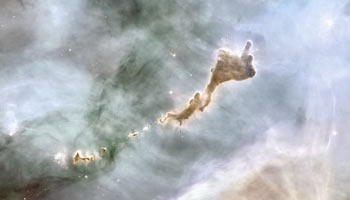Create a free profile to get unlimited access to exclusive videos, sweepstakes, and more!
Desktop Project Part 26: Carina will keelhaul your brain

[The Desktop Project is my way of forcing myself to write a post about the astronomical images I've been saving to my computer's desktop and then ignoring. I've been posting one every day for nearly a month, and this, my friends, is it. The last one. And I saved it for this occasion, because it's ridiculously awesome. Thanks for bearing with me as I did this bit of housecleaning.]
The constellation Carina is a mess. It represents the keel of a ship, but in the sky it happens to be in the direction of the disk of our galaxy, which is like having a window in a building facing downtown in a busy city. And like an urban center, the Milky Way in that direction is lousy with gas, dust, stars... and much of this is chaotic, disturbed, and, well, messy.
Oh, but what a glorious, glorious mess. Behold! The Carina Nebula!
[Click to ennebulenate, or grab this ridiculously huge 13,000 x 9000 pixel monster version. And yes, you very, very much want to make this bigger.]
Holy wow! I love this image! It's got it all: stars of every color studding a riotous background of gas, itself glowing red or reflecting blue, silhouetted in great ostentatious sweeps of dust. Shock waves riddle the gas, compressing it here and there in arc, loops, streamers, and filaments.
It's ridiculous, and spectacular.
The image was taken using the HAWK-1 detector on the European Southern Observatory's Very Large Telescope. This is an infrared picture, using colors outside what the human eye can detect. In the picture, what you see as blue is actually light at 1.25 microns, green at 1.65, and red at 2.2 microns. For comparison, the reddest color the eye can see is about 0.7 microns. Amazingly, in visible light this region is even more chaotic looking.
The Carina Nebula is about 7500 light years away, and is the site of a lot of star formation. Many of the stars being born are very massive, which makes them hot, blue, and frighteningly luminous. See that bright star in the lower left? That's Eta Carina, one of the most massive stars in the galaxy. To give you an idea of how stupid violent and unstable that star is, in 1843 it erupted in an explosive event that rivaled a supernova. The star held together, barely, but it ejected two lobes of matter that have about as much mass as the Sun. Each. And they're expanding at 700 km/sec (400 miles per second), fast enough to cross the continental United States in 12 seconds.
And one day Eta Car will explode. It's too far away to hurt us, but what a sight that'll be! And even now, just sitting there not exploding, it still shines about 4 million times brighter than the Sun. Four million. If the Earth were as close to Eta Car as we are to the Sun, we'd be vaporized into an ionized memory.
The HAWK-1 image is actually high enough resolution to get a lot of detail. Here's a collection of nine interesting regions:
[Click to embiggen, or grab this 4500 x 4500 version.]
These are all cool shots, but in the center is something odd: the cluster Trumpler 14, which is such a massive collection of hot stars that their combined light and stellar winds apparently is blowing gas back into that bow shock shape on the lower left. There are something like 2000 stars in that cluster alone, including one monster that has 80 times the mass of the Sun, near the theoretical limit of how big a star can be without tearing itself apart.
 My favorite, though, is the picture in the upper left. There are various names for the long, dark globule of dense dust there -- some less couth than others -- but if you flip it over (like in this picture here, a Hubble image from 2007) it really does look like the nebula is flipping off the Universe.
My favorite, though, is the picture in the upper left. There are various names for the long, dark globule of dense dust there -- some less couth than others -- but if you flip it over (like in this picture here, a Hubble image from 2007) it really does look like the nebula is flipping off the Universe.
And honestly, if you were sitting in the middle of all that mess, wouldn't you?




























